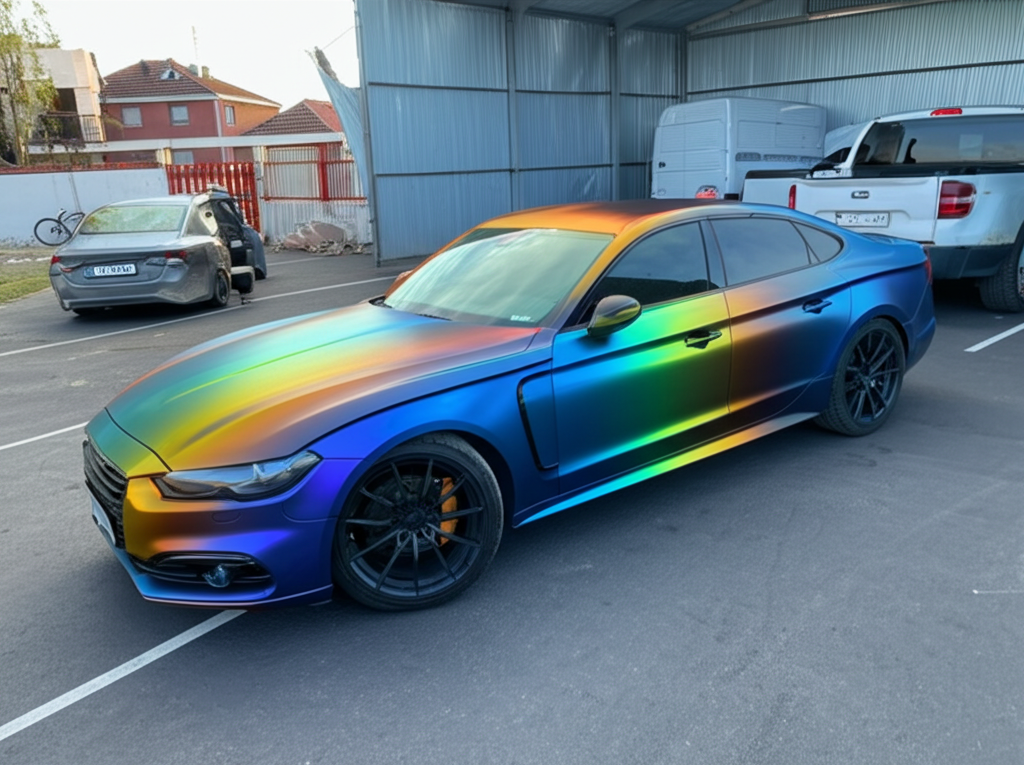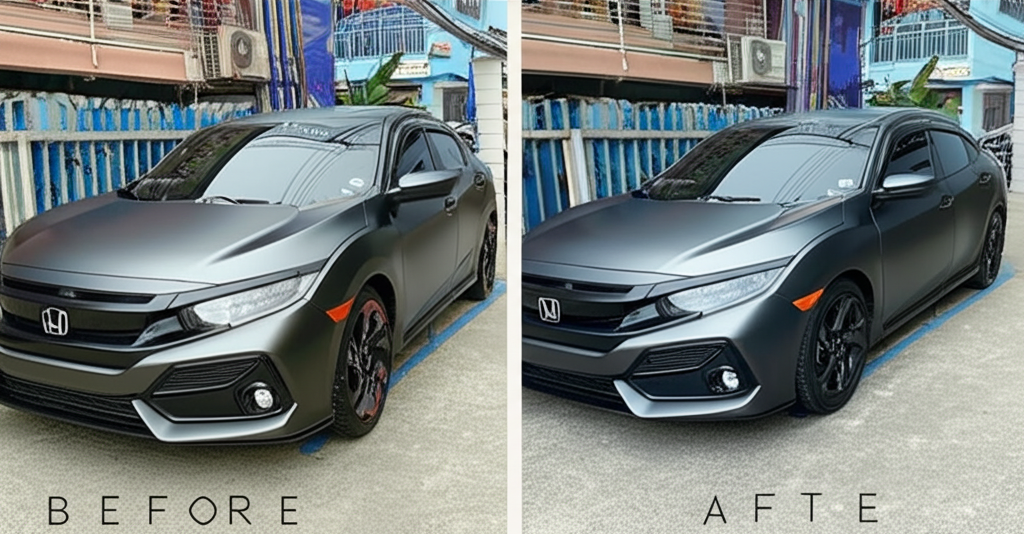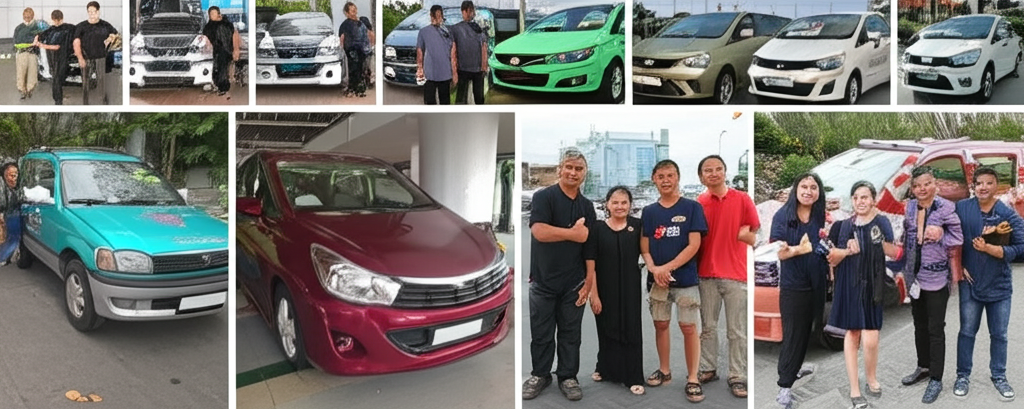Congratulations on your new car! That feeling of driving off the dealership lot in Thailand, the smell of newness, the promise of adventures on the open road – it’s exhilarating. But perhaps as you navigate the vibrant streets of Bangkok or cruise along the coast, you see other cars turning heads with stunning colours and finishes not available from the factory. You start thinking, “How can I make *my* new car truly unique, truly *mine*?” Maybe a bold matte black? A shimmering pearl white? Or perhaps a vibrant electric blue?
This leads you to the world of car wrapping – a fantastic way to completely change your vehicle’s appearance without a permanent paint job. But then, a common worry surfaces, especially for new owners: Is changing my car’s colour with a wrap even legal in Thailand? What are the rules? What kind of wrap should I choose? Is it durable? Will it protect my precious original paint? You’re excited about the possibilities but hesitant because of the unknowns. Don’t worry, you’re not alone. Many new car owners in Thailand share these exact concerns. This guide is here to walk you through choosing your first car wrap, understanding the options, and crucially, ensuring you stay fully compliant with Thai regulations.

Real Story: Anicha’s Honda Civic Transformation in Chiang Mai
Meet Anicha, a young professional who recently bought her first car, a brand-new Honda Civic, in Chiang Mai. She loved the car’s reliability but felt the standard silver colour didn’t quite match her personality. She dreamed of something more sophisticated, perhaps a deep satin grey. Browsing online, she discovered car wrapping and was instantly intrigued by the variety of colours and finishes available.
However, like many first-timers, Anicha was worried. “I heard stories about police stops for modified cars,” she explained. “I didn’t want any trouble, and I definitely didn’t want to damage the new paintwork.” Her research led her to a reputable wrapping specialist in Chiang Mai. During the consultation, they discussed her vision, showed her samples of high-quality wrap films (like Avery Dennison and 3M), and explained the different finishes – gloss, satin, matte, even textured options.
Crucially, the specialist explained the legal process in Thailand. They assured her that changing the car’s colour with a wrap is perfectly legal, provided you notify the Department of Land Transport (DLT) within the stipulated timeframe (usually 15 days after the wrap is completed) to update the vehicle’s registration details (Lem Tabian / Blue Book). Many reputable shops even offer assistance with this notification process.
Feeling reassured, Anicha chose a premium satin dark grey film. The professional installation took a couple of days. When she saw the result, she was ecstatic. “It looked like a completely different car! So sleek and exactly what I wanted,” she beamed. The wrap felt durable, and she was relieved to know the original silver paint underneath was perfectly protected. The shop helped her with the DLT notification paperwork, making the entire process smooth and worry-free. Now, Anicha drives her unique Civic with confidence, knowing her stylish modification is fully legal and her factory paint is preserved.

Knowledge Hub: Colour Change Wraps vs. Paint Protection Film (PPF)
When exploring vehicle customisation and protection, you’ll often hear about both colour change wraps and Paint Protection Film (PPF). While both are films applied to your car’s exterior, they serve fundamentally different primary purposes. Understanding the difference is key to making the right choice for your needs:
Colour Change Vinyl Wraps: These are primarily chosen for aesthetics. They allow you to completely change your car’s colour and finish. Think of it like a high-quality, removable “skin” for your car. While they offer a degree of protection against minor scratches, UV rays, and road grime, their main job is transformation.
Paint Protection Film (PPF): This is a thicker, typically transparent urethane film designed specifically for protection. Its main goal is to shield your car’s original paint from stone chips, scratches, bug splatter, bird droppings, and other environmental contaminants. While some coloured PPF options exist, the vast majority are clear, preserving the original look of your paintwork while offering superior impact resistance.
Here’s a table comparing the key aspects:
| Feature | Colour Change Vinyl Wrap | Paint Protection Film (PPF) |
|---|---|---|
| Primary Purpose | Aesthetic transformation, changing colour/finish | Protecting original paint from physical damage (chips, scratches) |
| Appearance | Opaque, huge variety of colours, textures (gloss, matte, satin, chrome, carbon fibre look, etc.) | Typically transparent/clear (to show original paint), some limited colour/matte options |
| Thickness | Generally thinner (around 2-4 mils / 50-100 microns) | Generally thicker (around 6-10 mils / 150-250 microns) |
| Self-Healing Properties | Available on some premium vinyl wraps, but less common | Common feature on most quality PPF (minor scratches disappear with heat) |
| Protection Level | Good against minor scratches, UV, dirt. Limited impact resistance. | Excellent against stone chips, deep scratches, impacts, stains. |
| Cost (Typical Range in Thailand) | ฿20,000 – ฿80,000+ (Depends on car size, film quality, complexity) | ฿30,000 – ฿150,000+ (Depends on coverage – front end vs full car, film quality) |
| Durability / Lifespan | 3-7 years (depending on film, climate exposure, care) | 5-10+ years (depending on film, climate exposure, care) |
| Legality (Colour Change Aspect in Thailand) | Requires DLT notification if colour differs significantly from registration book. | No notification needed if clear PPF is used. Coloured PPF would require notification. |
| Reversibility | Yes, professionally removable without damaging good condition factory paint. | Yes, professionally removable without damaging good condition factory paint. |
The Legal Requirement in Thailand: This is crucial. If you apply a colour change wrap that makes your car’s colour different from what’s listed in your vehicle registration book (Lem Tabian), you must inform the Department of Land Transport (DLT) within 15 days of the change. This involves submitting a form (available at the DLT office or sometimes downloadable online), presenting your car for inspection, and paying a small fee to update the registration book. Failure to do so can result in fines if stopped by the police. Reputable wrap installers in Thailand are well aware of this requirement and can often guide you through the process or offer assistance.

Hear From Fellow Car Owners: From Hesitation to Happiness
Making the decision to wrap your new car can feel like a big step. Hearing from others who have gone through it can be reassuring:
“I just got my new Toyota Yaris and wanted something different. I was nervous about the wrap maybe looking cheap or peeling, and honestly, the whole DLT notification thing sounded like a hassle. But I went for a matte metallic blue wrap from a recommended shop in Bangkok. The quality is amazing! It looks factory-finished. The shop handled the DLT paperwork too. Now I get so many compliments, and I feel relieved knowing it’s all legal and my paint is safe!” – Pipat, Bangkok
“My biggest worry was damaging the original paint on my Mazda CX-5. I love the Soul Red Crystal colour but wanted to protect it from stone chips on highway drives outside Phuket. I initially thought about PPF but then saw a stunning satin black wrap. I decided to go for the wrap, figuring it offers some protection *and* a cool new look. After a year, the wrap still looks perfect, and I know my red paint underneath is pristine. The transformation from bright red to stealthy black felt incredible!” – Siriporn, Phuket
“As a first-time car owner (MG ZS), I was overwhelmed with choices. Gloss? Matte? What brand? Is it worth the money? I spent weeks researching. I finally chose a gloss liquid copper wrap. The best part was the installer patiently explaining the care instructions – hand wash, no harsh chemicals. Seeing my ordinary SUV transformed into something so eye-catching was pure joy. It feels more ‘me’ now, and knowing I followed the rules gives me peace of mind on the road.” – Nattapong, Chonburi
These owners moved from initial uncertainty and concern (about legality, paint damage, quality) to feelings of excitement, satisfaction, and pride in their personalised, legally compliant vehicles.

Ready to Transform Your Ride? Let’s Talk!
Feeling inspired? A car wrap is more than just a colour change; it’s a statement of your personality, a way to protect your investment, and a reversible option that keeps your factory paint pristine. Whether you desire a subtle satin finish, a bold gloss colour, or a unique textured look, the possibilities are vast.
Navigating the choices – film type, brand, finish, and ensuring you follow the legal steps with the DLT – can seem daunting at first. That’s where expert advice comes in. We can help you understand the best options for your specific car, budget, and style preferences, and guide you on the necessary procedures in Thailand.
Don’t let uncertainty hold you back from making your new car truly yours. Contact us today for a free consultation! Let’s explore the exciting world of car wraps together.
📱 Want to learn more about car wrap & paint protection?
Feel free to reach us on LINE:

🌐 Official Website: https://tpuwraps.com
Frequently Asked Questions (FAQ) for New Car Owners in Thailand
- Q: Is changing my car colour with a wrap actually legal in Thailand?
- A: Yes, absolutely! Applying a colour change wrap is legal in Thailand. However, it is mandatory to notify the Department of Land Transport (DLT) within 15 days after the wrap installation is complete if the new colour significantly differs from the one registered in your vehicle’s blue book (Lem Tabian). This involves updating your registration details. Reputable installers can advise or assist with this simple process.
- Q: How long will a car wrap last, especially in Thailand’s hot and humid climate?
- A: The lifespan of a quality car wrap typically ranges from 3 to 7 years. This depends heavily on the quality of the vinyl film used (brands like 3M, Avery Dennison, Oracal are reputable), the quality of the installation, how much sun exposure the car gets, and how well you maintain it. Thailand’s strong sun can reduce longevity compared to cooler climates, so choosing a UV-resistant film and parking in the shade when possible helps. Regular, gentle hand washing is recommended.
- Q: Will a wrap damage my new car’s original paint?
- A: No, a professionally applied and removed quality wrap should not damage your car’s original factory paint. In fact, it acts as a protective layer against minor scratches, UV fading, bird droppings, and road grime. Problems usually only arise if the paint was already in poor condition (e.g., previous poor respray, rust) or if the removal is done improperly or with low-quality film.
- Q: What is the average cost of getting a car wrapped in Thailand?
- A: The cost varies significantly based on several factors: the size of your vehicle (e.g., small sedan vs. large SUV), the type and brand of vinyl film chosen (standard gloss/matte vs. premium finishes like chrome, textured, colour-shifting), the complexity of the installation (e.g., intricate bumpers, spoilers), and the reputation/skill of the installer. As a rough guide, expect prices to range anywhere from ฿20,000 for smaller cars with basic films up to ฿80,000 or even more for larger vehicles with premium materials and complex installations. Always get detailed quotes from reputable shops.
- Q: How should I care for my wrapped car? Can I take it to a regular car wash?
- A: Hand washing is the preferred method for maintaining a car wrap. Use a mild car wash soap (pH neutral) and soft microfiber wash mitts. Rinse thoroughly. Avoid automatic car washes with harsh brushes, high-pressure jets (especially angled at wrap edges), and strong chemical cleaners or waxes not specifically designed for vinyl wraps. Matte and satin wraps require specific care – avoid waxing or polishing them as it can create shiny spots. Your installer should provide specific care instructions.
Your Car, Your Style, Your Way (Legally!)
Choosing your first car wrap is an exciting step in personalising your new vehicle. It offers an incredible opportunity to stand out, express your style, and add a layer of protection to your original paintwork. While the options might seem endless and the thought of regulations initially concerning, remember that wrapping your car in Thailand is a well-established practice that is perfectly legal when the DLT notification process is followed correctly.
By selecting a quality film, partnering with a professional installer who understands both the craft and the local requirements, and performing the simple DLT notification, you can confidently transform your car’s look. Embrace the freedom of choice, protect your investment, and enjoy the thrill of driving a car that truly reflects you. Do your research, ask questions, and get ready to fall in love with your car all over again.
